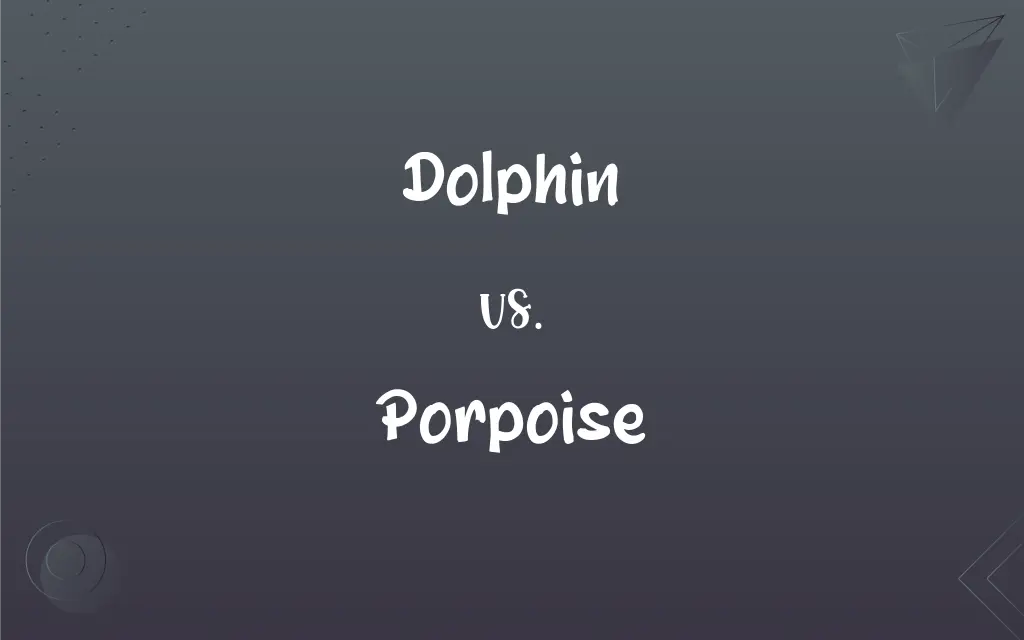Dolphin vs. Porpoise: What's the Difference?
Edited by Aimie Carlson || By Janet White || Updated on October 7, 2023
Dolphins are marine mammals known for their elongated mouths and playful nature, whereas porpoises have shorter beaks, are more robust, and tend to be more reserved.

Key Differences
Dolphins and porpoises, both marine mammals, belong to different families within the order Cetacea. Dolphins, members of the Delphinidae family, are characterized by their long, slender beaks and conical teeth. They are highly intelligent and known for their playful and acrobatic behavior, often seen riding waves and interacting with humans. Dolphins have a diversified diet consisting mainly of fish and squid and are found in various marine environments worldwide.
Porpoises belong to the Phocoenidae family and are distinguishable by their shorter, more robust bodies and flat, spade-shaped teeth. Unlike dolphins, porpoises are shy and less inclined to approach humans or boats. They mainly inhabit coastal waters and primarily feed on fish. Porpoises tend to have a more rounded, blunt snout compared to the elongated mouth of dolphins, contributing to their distinct appearance.
The social structures of dolphins and porpoises are markedly different. Dolphins typically form intricate social groups, exhibiting complex communication and cooperative hunting strategies. They use echolocation for hunting and navigating, emitting a series of clicks and whistles to interpret their surroundings. Dolphins are renowned for their intelligence and emotional capacity, displaying signs of self-awareness, problem-solving ability, and empathy.
Conversely, porpoises are relatively solitary creatures, often found in small groups. They are less vocal and their echolocation clicks are higher in frequency, making them inaudible to humans. While the cognitive abilities of porpoises are not as extensively studied as dolphins, they exhibit signs of intelligence and awareness. They are generally more elusive, avoiding interaction with humans and rarely breaching the water's surface.
Both dolphins and porpoises play crucial roles in maintaining marine ecosystems. They control fish populations and act as indicators of ocean health. However, they face threats such as habitat destruction, pollution, and bycatch. Conservation efforts are imperative to preserve these species and maintain the balance and diversity of marine life.
ADVERTISEMENT
Comparison Chart
Family
Delphinidae
Phocoenidae
Beak/Snout
Long and slender beak
Short and blunt snout
Teeth
Conical
Flat, spade-shaped
Behavior
Sociable, playful, and acrobatic
Shy, reserved, and less acrobatic
Group Size & Interaction
Form large, intricate social groups and interact with humans
Generally in small groups and tend to avoid humans
ADVERTISEMENT
Dolphin and Porpoise Definitions
Dolphin
A cetacean known for its advanced echolocation capabilities and complex social structures.
Researchers are studying dolphin communication to understand their social dynamics.
Porpoise
A small-toothed marine mammal with a robust body and a short, blunt snout.
The porpoise is often found in coastal waters, feeding on fish.
Dolphin
A marine mammal with a long beak and conical teeth, known for its intelligence and playful nature.
The dolphin entertained the spectators with its impressive acrobatic jumps.
Porpoise
A cetacean with flat, spade-shaped teeth, typically found in smaller groups.
Observing a porpoise in the wild can be challenging due to its elusive behavior.
Dolphin
A symbol of protection and friendship in various cultures due to its friendly and helpful behavior.
In ancient Greek legends, the dolphin is depicted as a helper of humankind.
Porpoise
A marine mammal known for its high-frequency echolocation clicks, inaudible to humans.
The porpoise uses echolocation to navigate and hunt in murky waters.
Dolphin
A member of the family Delphinidae, primarily inhabiting warm and temperate seas.
We spotted a pod of dolphins off the coast, riding the waves.
Porpoise
A creature with a streamlined body, adapted to aquatic life and rapid swimming.
The porpoise darted through the water in search of its prey.
Dolphin
A marine creature characterized by its streamlined body and ability to swim rapidly.
The dolphin gracefully maneuvered through the water, showcasing its agility.
Porpoise
Any of various marine toothed whales of the genus Phocoena and related genera, characteristically having a blunt snout and a triangular dorsal fin. Porpoises are placed either in their own family, Phocoenidae, or with the dolphins in the family Delphinidae.
Dolphin
Any of various marine toothed whales of the family Delphinidae, having a beaklike snout, a curved dorsal fin, and a slender streamlined body.
Porpoise
Any of several related aquatic mammals, such as the dolphins.
Dolphin
Any of several toothed whales inhabiting rivers and estuaries in South America and South Asia, having a long narrow beak, broad flippers, a flexible neck, and usually a reduced dorsal fin. A species native to the Yangtze River is thought to be extinct. Also called river dolphin.
Porpoise
A small cetacean of the family Phocoenidae, related to dolphins and whales.
Dolphin
See dolphinfish.
Porpoise
Any small dolphin.
Dolphin
See pompano dolphinfish.
Porpoise
(intransitive) Said of an air-breathing aquatic animal such as a porpoise or penguin: To repeatedly jump out of the water to take a breath and dive back in a continuous motion.
Dolphin
A buoy, pile, or group of piles used for mooring boats.
Porpoise
(intransitive) Said of an aircraft: to make a series of plunges when taking off or landing; or of a watercraft: to successively plunge up and down in the water.
Dolphin
A group of piles used as a fender, as at a dock or around a bridge pier.
Porpoise
Any small cetacean of the genus Phocæna, especially Phocæna communis, or Phocæna phocæna, of Europe, and the closely allied American species (Phocæna Americana). The color is dusky or blackish above, paler beneath. They are closely allied to the dolphins, but have a shorter snout. Called also harbor porpoise, herring hag, puffing pig, and snuffer.
Dolphin
A carnivorous aquatic mammal in one of several families of order Cetacea, famed for its intelligence and occasional willingness to approach humans.
Porpoise
A true dolphin (Delphinus); - often so called by sailors.
Dolphin
Tursiops truncatus, (Atlantic bottlenose dolphin) the most well-known species.
Porpoise
Any of several small gregarious cetacean mammals having a blunt snout and many teeth
Dolphin
A fish, the mahi-mahi or dorado, Coryphaena hippurus, with a dorsal fin that runs the length of the body, also known for iridescent coloration.
Porpoise
A member of the family Phocoenidae, characterized by its shy and reserved nature.
Unlike dolphins, a porpoise rarely approaches boats and humans.
Dolphin
(heraldry) A depiction of a fish, with a broad indented fin, usually embowed.
Dolphin
The dauphin, eldest son of the kings of France.
Dolphin
(history) A mass of iron or lead hung from the yardarm, in readiness to be dropped through the deck and the hull of an enemy's vessel to sink it.
Dolphin
(nautical) A kind of wreath or strap of plaited cordage.
Dolphin
(nautical) A spar or buoy held by an anchor and furnished with a ring to which ships may fasten their cables.
Dolphin
(nautical) A mooring post on a wharf or beach.
Dolphin
(nautical) A permanent fender designed to protect a heavy boat or coastal structure from the impact of large floating objects such as ice or floating logs.
Dolphin
One of the handles above the trunnions by which a gun was lifted.
Dolphin
(nautical) A man-made semi submerged maritime structure, usually installed to provide a fixed structure for temporary mooring, to prevent ships from drifting to shallow water or to serve as base for navigational aids.
Dolphin
A cetacean of the genus Delphinus and allied genera (esp. Delphinus delphis); the true dolphin.
Dolphin
The Coryphæna hippuris, a fish of about five feet in length, celebrated for its surprising changes of color when dying. It is the fish commonly known as the dolphin. The term is also applied to the related Coryphaena equisetis. Called also dolphinfish and (especially in Hawaii) mahimahi. See also dolphinfish and Coryphænoid.
Dolphin
A mass of iron or lead hung from the yardarm, in readiness to be dropped on the deck of an enemy's vessel.
Dolphin
A kind of wreath or strap of plaited cordage.
Dolphin
In old ordnance, one of the handles above the trunnions by which a cannon was lifted.
Dolphin
Large slender food and game fish widely distributed in warm seas (especially around Hawaii)
Dolphin
Any of various small toothed whales with a beaklike snout; larger than porpoises
FAQs
Are dolphins and porpoises the same animals?
No, dolphins and porpoises belong to different families and have distinct physical and behavioral characteristics.
Do both dolphins and porpoises use echolocation?
Yes, both use echolocation to navigate and hunt, but the frequency and range of their clicks differ.
Can both dolphins and porpoises live in freshwater?
Some dolphin species can inhabit freshwater, but porpoises are typically found in marine environments.
Are porpoises endangered?
Some porpoise species are considered endangered or vulnerable due to threats like bycatch and habitat loss.
Do both dolphins and porpoises face threats from human activities?
Yes, both face threats from activities like fishing, pollution, and habitat destruction.
Can porpoises be trained like dolphins?
Porpoises are less likely to be trained due to their elusive nature, while dolphins are more commonly trained due to their sociability and intelligence.
Are dolphins more intelligent than porpoises?
While dolphins are well-known for their intelligence, the cognitive abilities of porpoises are less studied, making direct comparisons difficult.
Are dolphins more social than porpoises?
Yes, dolphins typically form larger and more complex social groups compared to the relatively solitary porpoises.
Are porpoises smaller than dolphins?
Generally, porpoises are smaller and more robust compared to the sleeker and longer dolphins.
Can you see dolphins and porpoises in aquariums?
Dolphins are commonly seen in aquariums, while porpoises are rarely kept in captivity due to their specific needs and shy nature.
Do dolphins and porpoises have a similar diet?
Both primarily feed on fish and squid, but the specific diet can vary depending on the species and habitat.
Can both dolphins and porpoises communicate with each other?
Yes, both have communication abilities, with dolphins known for their complex vocalizations and porpoises using high-frequency clicks.
Do dolphins and porpoises have different reproductive patterns?
While both have similar reproductive patterns, the specifics like gestation period and breeding season may vary between species.
Are both dolphins and porpoises warm-blooded?
Yes, both are warm-blooded mammals adapted to live in aquatic environments.
Are there different species of dolphins and porpoises?
Yes, there are multiple species of both dolphins and porpoises, each adapted to different habitats and ecological niches.
About Author
Written by
Janet WhiteJanet White has been an esteemed writer and blogger for Difference Wiki. Holding a Master's degree in Science and Medical Journalism from the prestigious Boston University, she has consistently demonstrated her expertise and passion for her field. When she's not immersed in her work, Janet relishes her time exercising, delving into a good book, and cherishing moments with friends and family.
Edited by
Aimie CarlsonAimie Carlson, holding a master's degree in English literature, is a fervent English language enthusiast. She lends her writing talents to Difference Wiki, a prominent website that specializes in comparisons, offering readers insightful analyses that both captivate and inform.































































